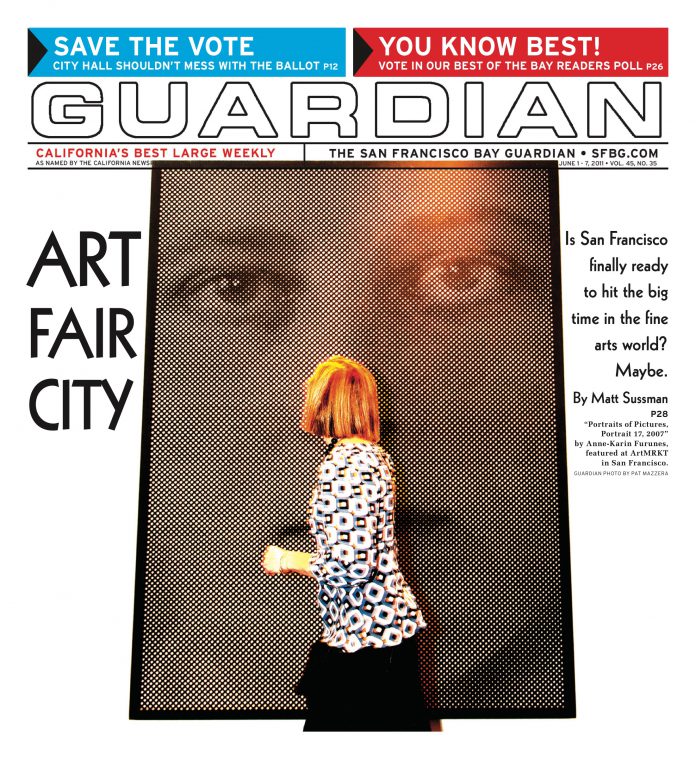arts@sfbg.com
DANCE The Ka-Ren people, who live on the border between Thailand and Burma and who have never recognized these political divisions, are known for their indigenous jewelry-design traditions. They didn’t get a gemologist in Ledoh, though they did get a dealer in a different kind of jewel — dances — and not because of a well-developed plan. Rather, it was serendipitous.
Performer-choreographer Ledoh — one name only, as is common among the Ka-Ren — came to this country at age 11 when his father realized that the family, although relatively well-off economically, might not have much of future in Burma. (Ledoh’s preferred name for his country; it is also called Myanmar.) The boy found the contrast between “garden parties and embassy events” and “having to take care of my sisters and slug to the Laundromat in the snow” striking, to say the least. But he dove into his American life, focusing his energy on visual arts and athletics. Dance, and butoh in particular, was nowhere near his horizon. But the Ka-Ren culture was ingrained into his DNA.
After college, on his way to Bangkok to study gemology — “I wanted to help my people,” Ledoh explains in a post-rehearsal conversation — his life took an unexpected turn. During a stopover in Kyoto, a friend took him to a butoh concert by one of the Japan’s great practitioners, Katsura Kan. Ledoh was hooked, and an intended three-month stay in Asia turned into three years.
This weekend sees the premiere of another of Ledoh’s full-evening works, Suicide Barrier: secure in our illusion, choreographed and performed by himself and dancers Iu-Hui Chua and Tammy Ho.
Even though he has lived in San Francisco since 1998, Ledoh has stayed on the margins of Bay Area dance. For one thing, he works very slowly. You can expect about one piece every two years; in the swirl of local dance-making, their impact has been low-key until recently. He gets an idea, he explains, “and then I crawl under a rock and come out when it’s time to do so.” The name of his company, Salt Far, says it all. Salt is the result of crystallization when “nothing is left except the essence of what there was.” His most recent work started as Signature Required: Life During Wartime, a response to 9/11 that evolved into ColorMeAmerica, a meditation on a personal journey through a strange land. It took him two-and-a-half years to complete.
While the influence of butoh is unmistakable in the choreographer’s work, the label doesn’t quite stick. Borrowing a definition from film, he calls what he does “butoh vérité.” He wants to pierce the genre’s trappings — glacial speed, bodily distortions, and white body paint — and focus the attention on the reality underlying the external phenomena.
Ledoh also works out his pieces into the smallest details. Nothing is left to chance. They are tightly structured multimedia events evincing a hands-on approach to integrating dance, sound, and visual elements. For Suicide he is again working with composer Matthew Ogaz and videographer-media artist Perry Hallinan.
All these aspects of Ledoh’s artistic temperament have earned him the admiration of ODC Theater director Rob Bailis. ODC Theater, in collaboration with Circuit Network, is producing Suicide. “Frankly, Ledoh is a genius,” Bailis says. “He is extremely diligent, lives a good long time with a subject, and comes to the table with a well-realized and courageous approach to a topic.”
Ledoh lives in Sonoma and San Francisco. His daughters, whom he had to take to their piano lessons between a rehearsal and this interview, live in SF. The eternal commute between the two places may well have sown the seeds for what has become Suicide. The Golden Gate Bridge Authority is considering installing a wall and a net to discourage jumpers. The intent may be to save lives but, in all likelihood, an ancillary purpose may be avoiding lawsuits. It’s a very fractured approach to seeing reality.
For Ledoh, this act of wall-building became an image of a self-deception that inevitably alienates us from full consciousness. For some, that blindness is hubris; for others, it means an inability to see the “other.” In his work, Ledoh tries to penetrate the false sense of reality and security that he observes everywhere in contemporary life. It’s in the dancer whom he sees only as a reflection thrown back by a mirror — and in the shopper who walks the aisles of a supermarket. He finds it even in the Ka-Ren, who, with the advent of ecotourism, “are now stuck in a game reserve of a natural forest.”
In a publicity shot, Ledoh is shown with a white flower stuck in his mouth. Is it a chrysanthemum, a funeral flower in many cultures? “It is a Gerbera daisy, and yes, it is a mourning flower for me,” he explains. The Ka-Ren grow them — for export.
Ledoh is not naïve about our ability to break through the walls we build around ourselves. He calls it “chasing our tail and never biting into it.” In his art, he tries to get as close as he can. Butoh, he says, is the means to “keep it honest, not to stylize,” which would distort the perspective. Working with the exquisite, ballet-trained Ho, he whispers images to her: “brush it away”; “reach for the apple.” These images, he later explains, are grasped by the mind that then has to let them sink inside the body. Gradually, Ho transforms herself into a vessel beyond what she thought she was. Then the choreographer encourages her to open and neutralize her eyes. When she no longer focuses, her eyes have become lenses through which we can look inside.
SUICIDE BARRIER: SECURE IN OUR ILLUSION
Fri/3-Sat/4, 8 p.m.; Sun/5, 7 p.m., $15–$18
ODC Theater
3153 17th St., SF (415) 863-9834 www.odctheater.org

